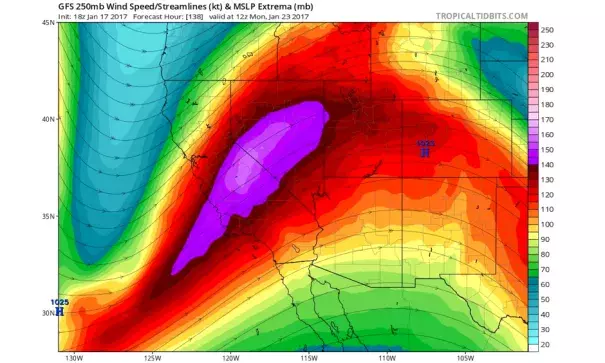New series of storms to bring renewed California flood concerns, especially in south

A very wet and stormy period over the past month in California has brought about a dramatic reversal in fortunes in many drought-stricken regions. A series of very moist “atmospheric river” systems brought copious precipitation–in some of the typically wet mountain regions, liquid precipitation has been measured in feet. Widespread flooding of streams and smaller rivers occurred, and the Yolo Bypass on the Sacramento River has been opened for the first time in years. Numerous highway closures took place due to flooding and mudslides, and there have been several levee breaches (although so far impacts of these breaches have thus far been relatively minor).
After a couple of bouts of very warm rains, even at very high elevations, the most recent storm systems have been associated with a much colder modified Arctic airmass. The combination of cold temperatures and and an active storm track brought a tremendous amount of snowfall to virtually all mountain areas of northern and central California (at the highest mountain peaks, as much as 10-20 feet of snow!). In some places, especially along the crest of the Sierra Nevada, the last storm in this series brought extreme and crippling blizzard conditions. Parts of the Lake Tahoe region are still digging out after many feet of snow and nearly hurricane-force winds brought widespread disruptions to the power grid and transportation infrastructure.
Rainfall–and, especially, snowfall–of this magnitude has not been seen in California since before the start of our severe multi-year drought. Unsurprisingly, this recent precipitation has brought considerable drought relief to the northern two thirds of the state. In fact: from a surface water perspective (i.e., relating to the water present in rivers, lakes, and man-made reservoirs), the drought may effectively be over across much of Northern California. Two major caveats to consider: severe to extreme drought conditions persist across much of Southern California, and even in northern California groundwater aquifers remain severely depleted after years of record warmth and dryness. Still, it has been a very long time indeed since Sierra Nevada snowpack was well above average, as it is today. And on a statewide basis, 2016-2017 is actually tracking pretty close to the wettest year on record so far (though conditions have been less anomalously wet in the south). All in all, I think it’s fair to say that there is finally some good news to be had on the California drought front.


